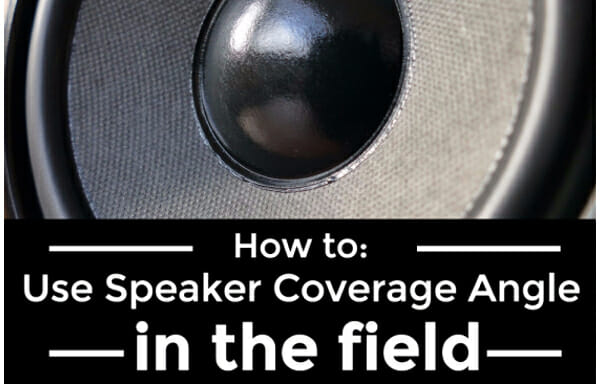In part 1 of this series on speaker coverage angle we defined speaker coverage angle, how to measure it, and three easy ways to implement it. Today we are going to get into more detail about exactly how to use it. But first…
What if I don’t know the coverage angle of my speaker?
Some speaker manufacturers are nice enough to write this on the back of the box, but most are going to make you look it up on their website. Nine times out of ten, that will work. In some cases, with legacy products or DIY boxes, you may need to figure it out on your own.
Watch out! The trapezoidal shape of your speaker box does not indicate coverage angle. There are a few exceptions, including the Meyer Sound JM-1P. To measure your speaker’s coverage angle you are going to need to break out your Smaart or SATLive rig.
Place your measurement microphone on-axis 3-4m from the speaker.
Take a measurement and save the trace.
Now, referencing the saved trace, rotate the speaker in place until the 8kHz region drops 6dB. It might be easier to offset your saved trace by 6dB and just rotate the speaker until the live trace matches the saved trace.
Measure the speaker’s rotation with a protractor. Multiply that number by 2. The result is your speaker coverage angle.
Use coverage angle to place your speakers
A lot of times we arrive on site to find a pile of equipment and we have to figure out how to make it all work in a short amount of time. The first thing I do is take a quick inventory of my speakers and their coverage angles. If there are only two or three models, I can start planning in my head. More than that and I need pencil and paper. This is my favorite part of the job where I get to put together the puzzle pieces. As always, I try to keep it simple. How can I cover the entire audience with as few speakers as possible? The fewer the speakers, the fewer problems down the road. One of the most common mistakes I see people making is to use speakers that are too wide. If you have a long skinny room, you will probably be better served with your narrow coverage speakers. Let’s look at an example so you can see what I’m talking about.
Imagine that you had 100º, 70º, and 40º speakers available. Which would you use in this room? In my opinion, the 40º option would be the best fit. Then I would use the 100º speaker for a center fill. Another common mistake I see people making is to place their wide coverage speakers too close to each other, causing a lot of overlap and comb filtering. In this example of a wide room we can see four 100º speakers with a lot of overlap.
What if we spaced them out so that their off-axis points lined up across the front row? Looks like we would have better coverage along the front, but still not enough on the sides. At this point, we need to add more speakers as side fills or push our mains away from the stage and add front fills.
Use coverage angle to aim your speakers
It’s very uncommon that a speaker’s coverage will perfectly match the room shape. Usually, there will be some overlap and I’ll need to decide where to put it. When aiming my speakers I don’t want to hit too much of the wall or too much of the stage. I use my aiming triangles (download here) and my laser to rotate the speaker until it is no longer hitting the nearest wall. Then I’ll look at the other side and see if it is hitting the stage. If it is, I’ll rotate the speaker back out until it is off the stage. The reason I do this that the GBF (gain before feedback) of my microphones on stage take priority over the potential for comb filtering created by reflections from the wall. Here’s a short video I shot on my phone a few years ago at a hotel in San Francisco.
Find speaker aim using speaker coverage. from Nathan Lively on Vimeo.
Use coverage angle to array your speakers
The name of the game in combining one speaker’s coverage with another without it being a train wreck is making them meet at their off-axis points. If you have two 50º speakers, for example, in a coupled point source array, you’ll want to rotate each of those speakers by 25º to make their off-axis points align in the center. Now you effectively have a 100º speaker.
Pro tip: How do you know if two speakers will be happy in an array together? Their beamwidth’s should match. Beamwidth is coverage angle over frequency. Just because two speakers have matching coverage angles in the high frequencies doesn’t mean that they will continue to match into the low frequencies, which you need for consistent coverage.
Take Action
Now that you have a better understanding of how to use speaker coverage angle in the field, download my aiming triangles and put sound where the people are. For more on building great sound systems, sign up for Nathan Lively’s free e-course, Intro to Sound System Tuning at Sound Design Live.
